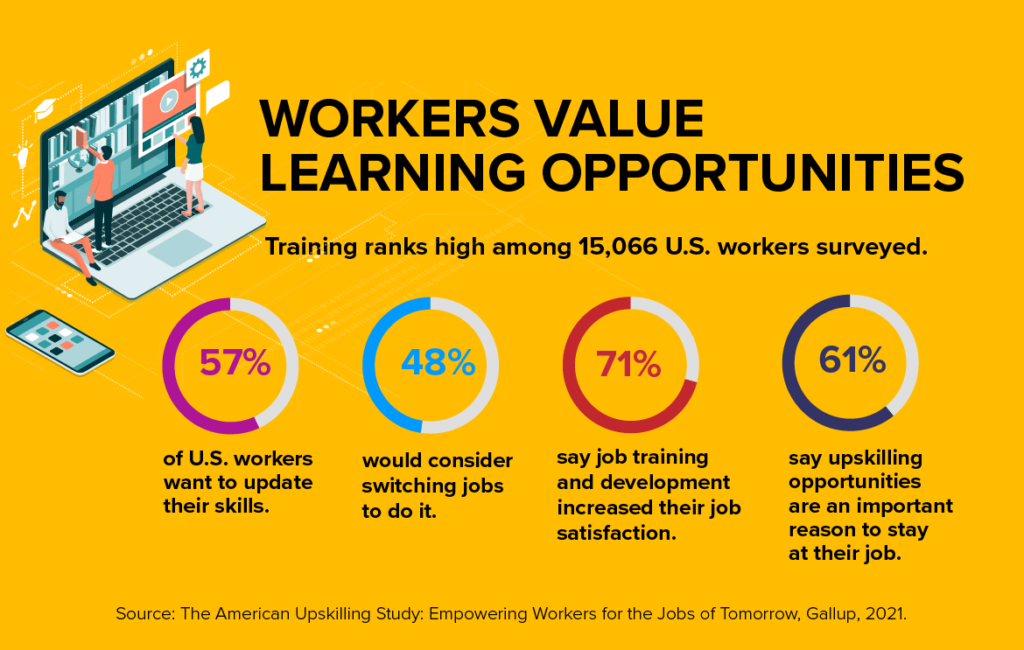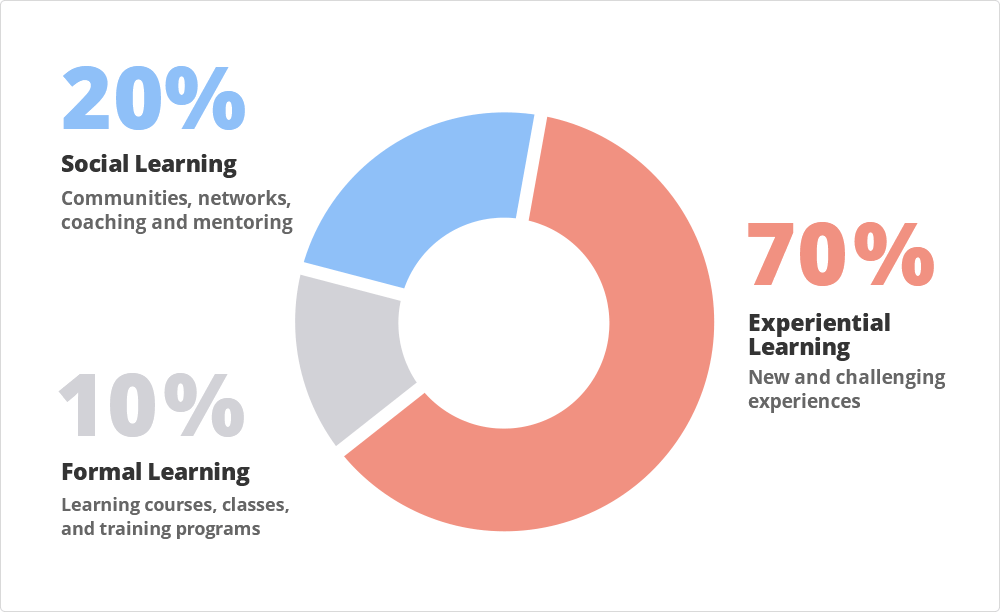Leadership is communicating people’s worth and potential so clearly that they come to see it in themselves.
Stephen Covey, global educator and business leader
I first heard the above quote while I was working for an organization that invited me to participate in their university program.
During the program, I expanded my network by meeting and learning from colleagues across the globe, taking in new concepts, perspectives, theories, and ways of thinking—opening my world to new possibilities.
It was inspiring! And from then on I knew that I wanted to pursue a career in learning and development (L&D). Over the years, I’ve taken pride in helping organizations grow their employees and better achieve their goals.
In this article, I’ll explain how creating a learning and development strategy is beneficial for organizations and how to develop one.
What Is A Learning And Development Strategy?
Simply put, a learning and development strategy aligns employees’ competencies with the organization’s strategy and vision. The strategy can be executed by one singular team or decentralized across a business or organization.
Organizations that examine the skill set of their workforce, and create a learning strategy that builds the capabilities of their employees, are more primed for success and sustainable growth. In other words, it helps the bottom line!
The Business Case For A Learning And Development Strategy
Wondering why learning and development is necessary?
Here are five reasons for your organization to explore and implement an L&D strategy:
- Attraction - you’re more attractive as an employer when you’re seen as one that caters to professional development.
- Onboarding - an effective learning and development strategy helps with knowledge sharing which makes new starter onboarding easier and makes them productive faster.
- Retention - people value opportunities to learn new skills and develop professionally—and they especially value this opportunity to get paid while doing it.
- Employee Engagement - an effective L&D strategy has been linked to higher levels of engagement and employee satisfaction.
- ROI - L&D has been proven to help businesses achieve their goals and improve organizational efficiency and hit more business objectives.

Great leaders know that investing in programs that drive attraction, retention, and engagement will lead to employees who invest back into the company through time, effort, and telling friends, family and the public they work for a great company!
Upskilling and reskilling have been highlighted by leaders of industry, talent management influencers and labor advocates because it's a business imperative at a time where technology is drastically changing the workplace.
Reworked.co shared some eye-opening stats on businesses that saw remarkable returns on their learning investment:
- Accenture: 353% return
- Cigna: 129% ROI from its educational reimbursement program between 2012 and 2014.
- Discover: 114% ROI on its tuition reimbursement efforts.
- Advocate Health Care: Education assistance program helped the company achieve a 4.3% ROI ($1.3 million in net savings from lower talent management costs).
Want similar results? Implement the next section.
The 7 Steps To A Robust L&D Strategy
The aim of learning and development is to help employees grow and nurture their potential while simultaneously helping the business meet current and future talent needs.
While every organization is different, the following steps will cement a solid foundation for your talent development and L&D strategy to help people learn and drive business results.
1. Know where you’re going
What direction is the business going? The first step is always aligning the learning and development strategy to your business goals, benchmarks, and priorities. This is where a lot of L&D can initiatives fall flat—aiming to improve employees with a guiding light of what kind of improvements are most needed.
For example, if the goal is to reduce employee turnover by 10% over the next 12 months, then establish and quantify the connection between the reduction in turnover and the investment in learning and development.
If the goal is a reduction of product defects, showcase employee output and productivity and organizational efficiency before and after implementing strategic learning programs.
Make the connection and tell the story of how your L&D program contributes to tangible outcomes, and put them in terms that speak to the big picture of the business’ growth.
2. Identify who will determine the learning and development vision and objectives
Who will make up the L&D team or program? Will it be Human Resources? A People or Talent team? Will it sync closely with a Performance Management team or owner? Will it roll up into a Revenue org if it’s meant to help with bottom line revenue?
This group will craft the organization's learning philosophy, make critical decisions associated with the L&D strategy, and own the processes associated with it.
Select critical thinkers and collaborators who will support the purpose and champion the cause.
3. Conduct an internal skill gap analysis
Next, assess current employee competencies against the business strategy. Any skill gaps and areas of focus will become clear.
How to assess—gather meaningful data from various channels:
- Employee surveys
- External customer feedback
- Performance reviews
- One-on-one (check-in with individual contributors and managers)
- Informal focus groups.
- 8-10 participants, including the facilitator and notetaker
- Include representation of the organization's employee population. Consider:
- Roles (from shop floor to CEO)
- Levels (individual contributors, managers, senior leadership)
- Global presence (regions, cultures)
- Top 3 questions to ask:
- What organizational, team or personal changes do you anticipate will take place in the next 12 months?
- What learning and development might you need to address these changes?
- What methods do you find most effective to acquire these skills, knowledge and behaviors?
4. Identify core learning and development needs
Now that you have gathered the data from a skills gap analysis, you're ready to pull it together to answer the question “What are the learning needs of the business?”.
Here you will want to highlight common themes, start to map out organizational priorities and your resources, and form a short-term and long-term strategy.
Engage the team by coming together (where you can) in person with a whiteboard, lots of pens, and a slew of multicolored sticky notes. If only online, I use tools like the Mural app.
The goal is to land on 2-3 learning priorities that are realistic and achievable. Be sure to include goals and benchmarks, make early projects cost-effective, and find low-hanging fruit that will have a noticeable influence to build your L&D brand among stakeholders.
5. Know what success looks like
Establish key L&D metrics and KPIs that are relevant and inform the business that the L&D strategy is on—or off—track.
The general rule of thumb is to assess at least once annually to ensure alignment with the direction of the business.
Common L&D metrics include:
- Training cost per employee (cost of training / number of employees)
- Employee performance post-training (quizzes, surveys, one-to-one, behaviors)
- Training ROI (Return of Benefit – Investment Cost) / Investment Cost x 100
- Measures the efficiency or profitability of the money you put into the training. It is usually linked to greater revenue and business impact.
- Training experience satisfaction (survey)
- Operational performance (grow sales, improve service efficiency and productivity, and maintain compliance)
- Retention
You can pull these data points from corporate learning management systems, surveys, and focus groups, to name a few.
6. Create learner profiles
The learner profile should identify each role that you want to create a profile for (ie. individual contributor, manager, senior leader), what learning methods learners typically use (i.e. cellphone, in-person meetings, laptop to access learning platforms), and when and where are they accessing the learning tools.
These can start off broad and narrow over time as you better understand your population of learners and the competencies needed across functions and levels.
This step in the process is all about opportunity—the opportunity to build effective relationships, develop an inclusive learning program, and understand what technology, differentiation, or adaptations may be needed for groups within each of the programs you’ll be setting up.
One way to identify learner profiles is through informal focus groups. A few questions to warm up the group include:
- How do you best work together and what tools do you use?
- What was your best learning experience? (pick out keywords—classroom, visual, books, mobile, easy to access, bite-sized learning)
- What would make your learning experience even better?
These profiles help to customize employee development to meet what your learners need. Each person is different and adults learn best when content is as relevant and specific to them as possible.
Understanding these preferences is also crucial when choosing an LMS that will meet your diverse learner needs.
7. Identify your delivery methods with a 70-20-10 learning strategy
Organizations are made up of a diverse group of individuals, each with their own learning style.
Leveraging the 70-20-10 model for learning and development provides a structured approach to identifying how your business will deliver identified learning programs.
Experiential learning has proven to be the most impactful as it offers on-the-job, relevant, and real-time employee training activities. Be sure to include this in your L&D strategy and be rewarded with higher engagement, attendance, and effort.
Stretch assignments, cross-functional projects, feed-forward processes, and field experience, are a few examples of where employees should be spending 70% of their development time. These types of activities connect classroom time with real-world experience.
When identifying social learning programs, consider both internal and external networks. External networks might include things like payroll seminars, which gives your team the oportunity to learn from others.
Employees spending 20% of their development time in these areas will see greater results from connecting with internal subject matter experts and leveraging mentors from external associations and the like.
Exploring outcomes from on-the-job learning with role models in their network deepens learning and forms new behaviors.
Formal learning, such as employee training programs held in the classroom, should only account for 10% of time spent on development. These types of learning are effective as they provide a space for learners to focus on taking in the information, away from the distractions of the work, while connecting with other learners.
In tandem, the 70-20-10 model for learning and development offers a structured and balanced approach to maximize the outcomes of employee development.
Learning And Development Creates Champions

Leadership is communicating people’s worth and potential so clearly that they come to see it in themselves.
StepHen Covey
We end with the initial quote from Stephen Covey.
As you begin building your learning and development strategy, I invite you to consider the legacy you want to leave as a leader in your organization (yes, we are all leaders!). Will it be a well intentioned program that lacks impact and engagement from employees, or a well designed framework for intentional growth?
Of course, organizations will see an ROI from a well-designed L&D strategy, and, even better, they will see employees feeling more confident in their abilities and open to new ways of working. This will also help you get leadership buy-in on your program as you become a key lever to hit business goals and priorities.
Now that you have the blueprint for an L&D strategy, why stop here? Explore specialized development courses and accelerate the impact on your business and greatest asset—your employees!
Some further resources:
- The 5 best Ted Talks for Learning & Development
- 7 Questions to ask During Training Needs Analysis
- Kirkpatrick’s Training Evaluation Model
- Putting employees in the driver’s seat of career development
- Why And How To Build An Internal Talent Marketplace
- Best Learning Management Systems
- Best Enterprise Performance Management Systems
- 5 Employee Learning Trends To Help Shape Your Learning Strategy
- 4 Key Learning And Development Metrics And How To Track Them
- Training Remote Workers: Strategies For Success In The Digital Age
- How To Create A Learning And Development Program To Grow Your Team (podcast)
Subscribe to the People Managing People Newsletter to receive fresh ideas on learning and development and people strategy every week.





